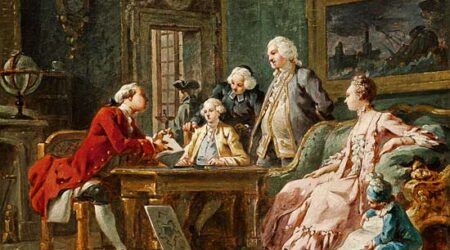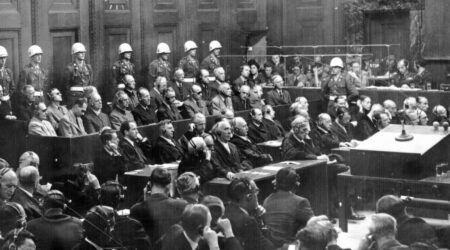One night in 1954, a group of Communists exhumed Karl Marx’s body from its obscure resting place in London’s Highgate Cemetery and moved it to a more prominent position along the central path. Since then, other eminent Marxists have been laid to rest in what has become the world’s most prestigious Communist burial plot, attracting thousands of visitors each year.
How did the bones of history’s most famous materialist end up as sacred relics?
Thomas Laqueur, a professor in UC Berkeley’s Department of History, offers some possible answers. Laqueur’s forthcoming book, The Work of the Dead: Oblivion and Civilization in the West (to be published by Princeton University Press later this year) draws on history, anthropology, and archaeology to explore why everyone from early Christians to twentieth-century Communists have cared for the dead.
“The dead actually do things for the living,” Laqueur says. “What they do is make concrete, represent, and create a set of social relationships through time.”
Laqueur has taught at Berkeley for more than 40 years. A specialist in early modern Britain, he has pursued research interests that span the history of culture, medicine, and the body. Laqueur’s previous books include Making Sex: Body and Gender from the Greeks to Freud and Solitary Sex: A Cultural History of Masturbation. At UC Berkeley, Laqueur is a popular lecturer and teaches a course called “Death, Dying, and Modern Medicine” with Clinical Professor Guy Micco, a physician at Berkeley’s School of Public Health.
Laqueur says his research on sex and death is connected: “I’m interested in how we come to understand what seem to be natural states in the body—and how they’re actually not so natural,” he explains. In other words, arousal and mourning alike are culturally constructed.
Death is “something I’ve been thinking about since I was a kid,” Laqueur says. His father was a pathologist, and sometimes brought home human organs he had removed for examination. After studying history at Princeton and Oxford, Laqueur eventually dissected a cadaver while on a fellowship to study medicine.
The Work of the Dead has been four decades in the making, Laqueur says. His initial interest in studying death in early modern Britain gradually turned into a thousand-page tome that essentially covers all of human history. The book is divided into two parts: “anthropological time,” examining continuities in how the dead have been treated for millennia, and “historical time,” which covers Western Europe from the Enlightenment to the early twentieth century, with a focus on England.
Humans are known to have buried their dead since at least the Upper Paleolithic Age (40,000 to 10,000 BCE). Some archaeologists suggest that Neanderthals did, too. From the beginning, Laqueur says, dead bodies have been “disenchanted”; we have long known that they decay, leading some to claim that caring for them is folly. Cicero wrote of the scandalous Greek philosopher Diogenes, who demanded that his corpse be tossed over the wall to be devoured by “birds and beasts.” “How am I then injured by being torn by those animals, if I have no sensation?” Diogenes asked. A couple of millennia later, Marx (and modern cremation advocates) would express a similar view.
At the same time, however, corpses have always been “enchanted.” They have played a role in the creation of new nations, as when French revolutionaries exhumed Voltaire’s remains to place in their Pantheon, or when the Bolsheviks installed Lenin’s mummy on Red Square. Conversely, a lack of care for physical remains has long been seen as the deepest affront, from ancient Greece—where, in Sophocles’ Antigone, King Creon was punished by the gods for leaving Polynices’ body to rot on the battlefield—to the Nazis, who left corpses of executed resistance fighters in the streets.
In his book, Laqueur traces several shifts in attitudes toward the dead body over time. The 19th century, for example, saw the rise of landscaped cosmopolitan cemeteries as the new burial ground of choice, replacing the traditional parish churchyard. Although this change is sometimes attributed to scientific discoveries about health and disease, Laqueur says that changing cultural values were the real driving force. As society grew more pluralistic, the Christian God became less important than the new, transcendent “gods” of nation and civil society. As a result, in cemeteries such as Paris’s Père Lachaise (established in 1804), we can today find the tomb of Jim Morrison near those of medieval philosophers, and Jewish remains are buried alongside those of Christians, which would have been unthinkable in centuries past.
Another shift that Laqueur points to is the growing importance of naming the dead, including listing deceased people’s names on tombstones. This was due in part to the state’s increasing role in keeping official statistics about the population. But Laqueur also sees naming as “constitutive of democracy,” creating a liberal society in which individual lives (and deaths) matter. After World War I, the proliferation of public memorials listing those killed in action marked the culmination of this shift.
An additional shift had to do with burial, which had been favored for centuries, until late nineteenth-century reformers championed cremation as the ultimate way to banish the superstitious past and achieve rational modernity—with mixed results.
Alongside all these shifts, the dead have exercised their essential power to “produce imagined communities over time,” Laqueur says. When spouses, party comrades, and national heroes are buried together, their bodies create meaning for the living.
In 1995, Laqueur and his wife Carla Hesse, who is Berkeley’s Dean of the School of Social Sciences, traveled to Hamburg, Germany, where he was to present a lecture. Laqueur’s grandfather is buried in Hamburg’s famed Ohlsdorf Cemetery, and Hesse suggested that they bring some of his father’s ashes to put on the grave. While Laqueur was initially skeptical—the ashes had long ago been mixed into a flowerbed—he eventually agreed.
“It actually meant a great deal to me,” Laqueur says. “It was a discovery that I, too, am susceptible to magic.” In the end, he both agrees with the philosopher Diogenes that dead bodies are food for birds and beasts, and thinks this is “impossible.”
Dead bodies might be just matter, but we persist in caring for them anyway; the rational and the magical always coexist. “A great deal of the history of humankind,” Laqueur says, “can be written as ‘yes, but.’”
To hear a lecture by Laqueur on “Why do we care for the dead?”—recorded at Swarthmore College, his alma mater—click here.



